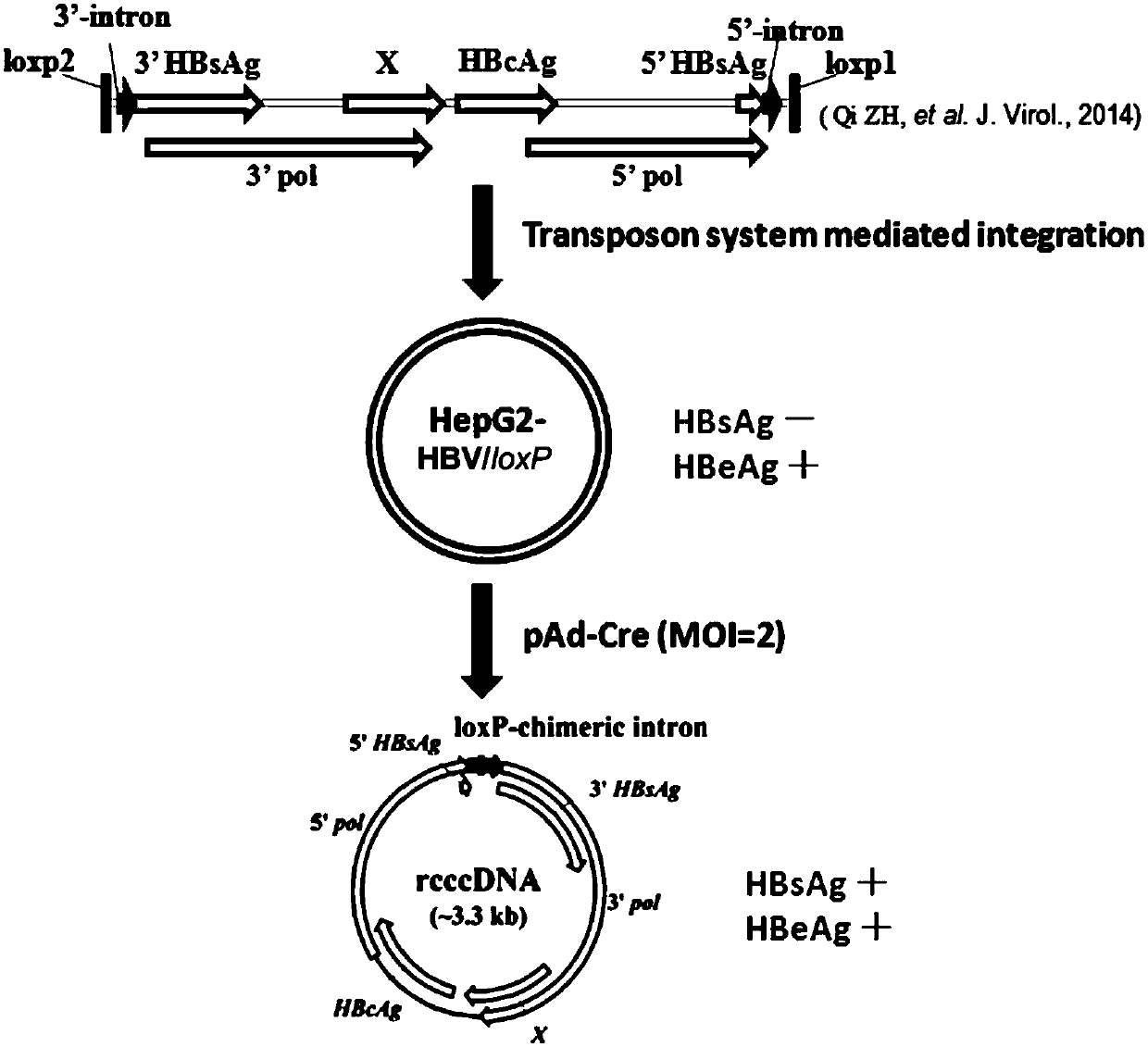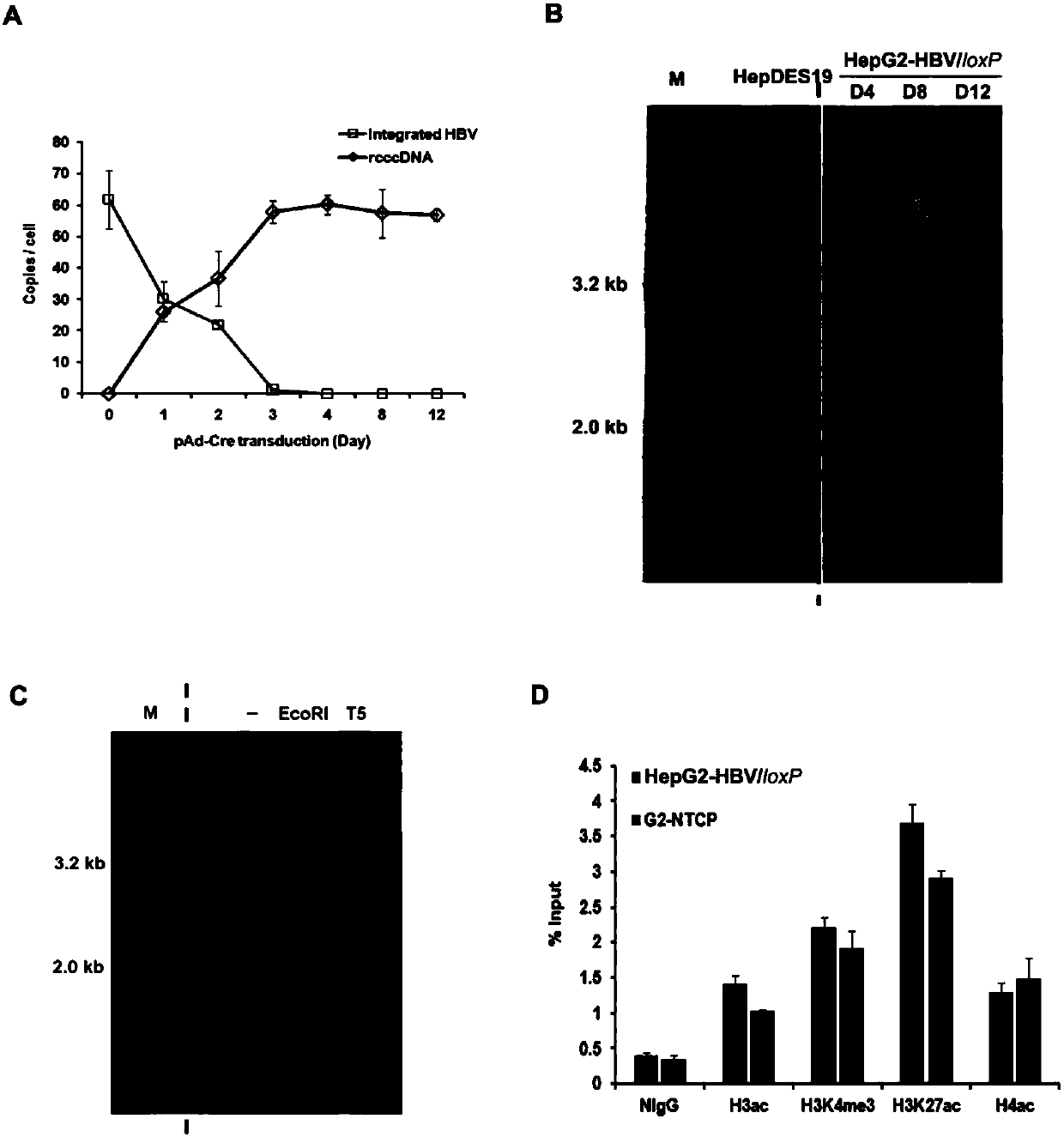Cell system for simply and efficiently generating hepatitis B virus (HBV) recombinant cccDNA
A cell line and cell technology, which can be applied to cells modified by introducing foreign genetic material, biochemical equipment and methods, applications, etc., and can solve the problems of difficult signal detection, high price, complicated and time-consuming cultivation operations, etc.
- Summary
- Abstract
- Description
- Claims
- Application Information
AI Technical Summary
Problems solved by technology
Method used
Image
Examples
Embodiment 1
[0034] The establishment of embodiment 1 HepG2-HBV / loxP cell line
[0035] ①Plasmid construction: The pSBbi-rcccDNA plasmid was constructed by inserting the pSBbi-GP vector plasmid (Addgene#60511) into the HBV single-copy genome with loxP sites at both ends; pCMV-SB100 is a Cre recombinase expression plasmid (Addgene#34879) .
[0036] ② Cell transfection: HepG2 cells were cultured in high-glucose DMEM medium (BI Company, containing 10% fetal bovine serum, 2 mM glutamine). The cells in logarithmic phase of growth were trypsinized and counted. Press 1×10 6 The concentration of cells / well was seeded into 6-well culture plates. Cultivate overnight, and use for transfection when the cells are about 80-90% confluent into sheets. According to the transfection amount of 2 μg per well, 1.8 μg pSBbi-rcccDNA and 0.2 μg pCMV-SB100 were diluted in 100 μl pure DMEM medium, and 100 μl pure DMEM medium was mixed with 12 μl PEI transfection reagent (Polysciences). Mix the diluted PEI with...
Embodiment 2
[0039] Example 2 pAd-Cre transduces HepG2-HBV / loxP cells to induce rcccDNA generation
[0040] ⑤Construction of pAd-Cre recombinant adenovirus: insert Cre recombinase expression sequence into adenovirus vector pAdPLDest to construct pAd-Cre plasmid, pAd-Cre plasmid was digested with PacI endonuclease and then transfected into HEK293 cells to produce pAd-Cre recombinant adenovirus Virus.
[0041] ⑥ pAd-Cre transduction: HepG2-HBV / loxP cells with 5×10 6 The concentration of cells / dish was inoculated on a 10cm culture dish, and 1×10 7 pAd-Cre recombinant adenovirus (MOI=2) was used for transduction. The cells were cultured in high-glucose DMEM medium containing 2% fetal bovine serum, and the medium was changed every 2 days.
[0042] ⑦ Southern Blot detection of rcccDNA: Hirt extraction method was used to extract rcccDNA, and Roche company's digoxin probe labeling and detection system was used for Southern Blot detection (DIG High Prime DNA Labeling and Detection Starter Kit II...
Embodiment 3
[0044] Example 3 Detection of related characteristics of rcccDNA (taking HepG2-HBV / loxP No. 6 clone as an example)
[0045] ①The generation of rcccDNA is fast and stable: the cells were collected at the corresponding time point after pAd-Cre transduction, the genomic DNA and rcccDNA were extracted, and the HBV sequence and rcccDNA integrated in the genome were detected by quantitative PCR; Primers for specific intronic sequences were used for detection. The results showed that the integrated HBV genome copy number in HepG2-HBV / loxP No. 6 clone was ~60 copies; 3 days after pAd-Cre transduction, the integrated HBV sequence in the cell genome was basically undetectable, while the generated rcccDNA copy number Reached ~60 copies / cell, indicating that after 3 days of pAd-Cre transduction, Cre cleavage and rcccDNA generation were basically completed ( image 3 A). The generated rcccDNA can exist stably in the cell for at least 12 days ( image 3 B).
[0046] ② The structural cha...
PUM
 Login to View More
Login to View More Abstract
Description
Claims
Application Information
 Login to View More
Login to View More - R&D
- Intellectual Property
- Life Sciences
- Materials
- Tech Scout
- Unparalleled Data Quality
- Higher Quality Content
- 60% Fewer Hallucinations
Browse by: Latest US Patents, China's latest patents, Technical Efficacy Thesaurus, Application Domain, Technology Topic, Popular Technical Reports.
© 2025 PatSnap. All rights reserved.Legal|Privacy policy|Modern Slavery Act Transparency Statement|Sitemap|About US| Contact US: help@patsnap.com



